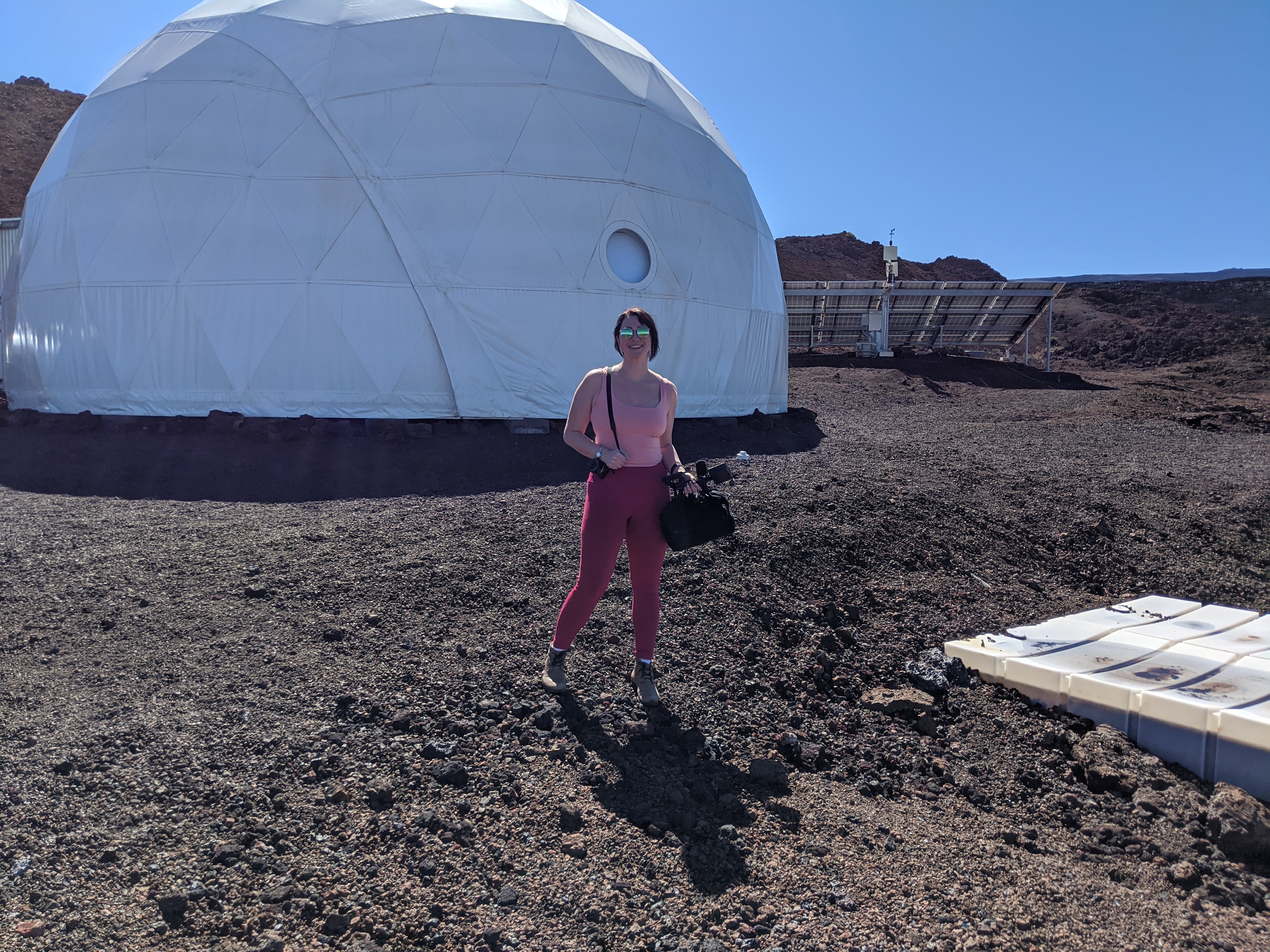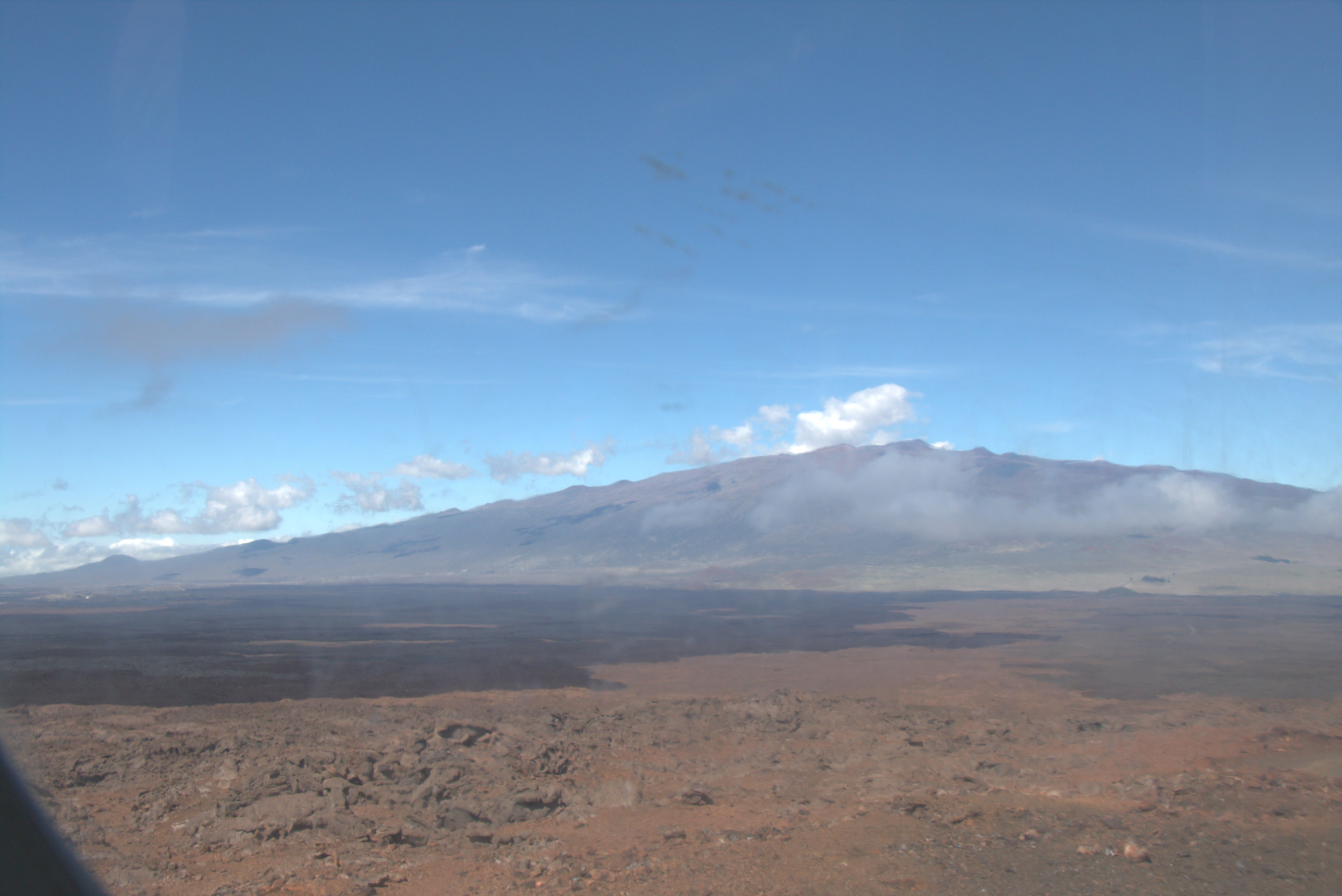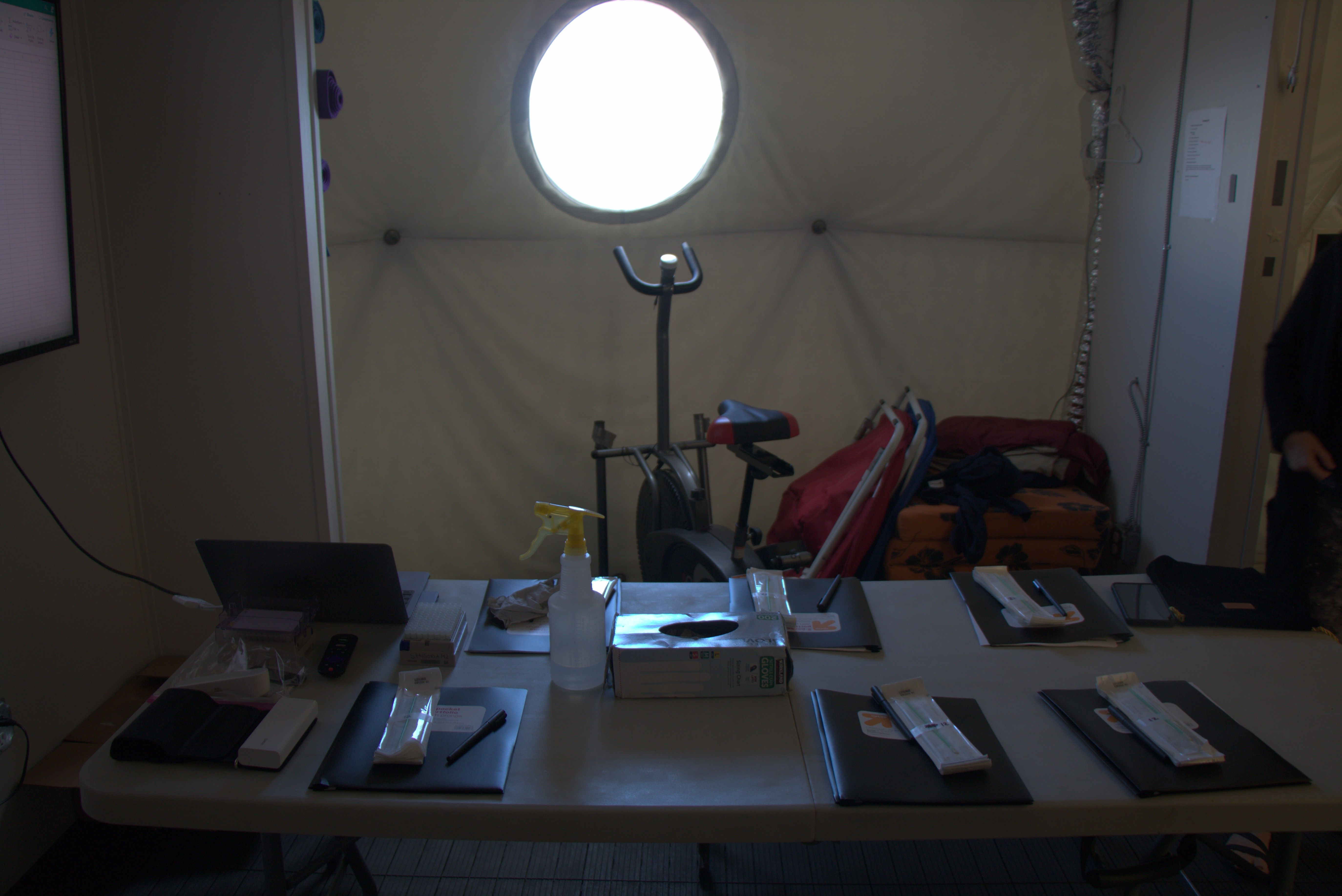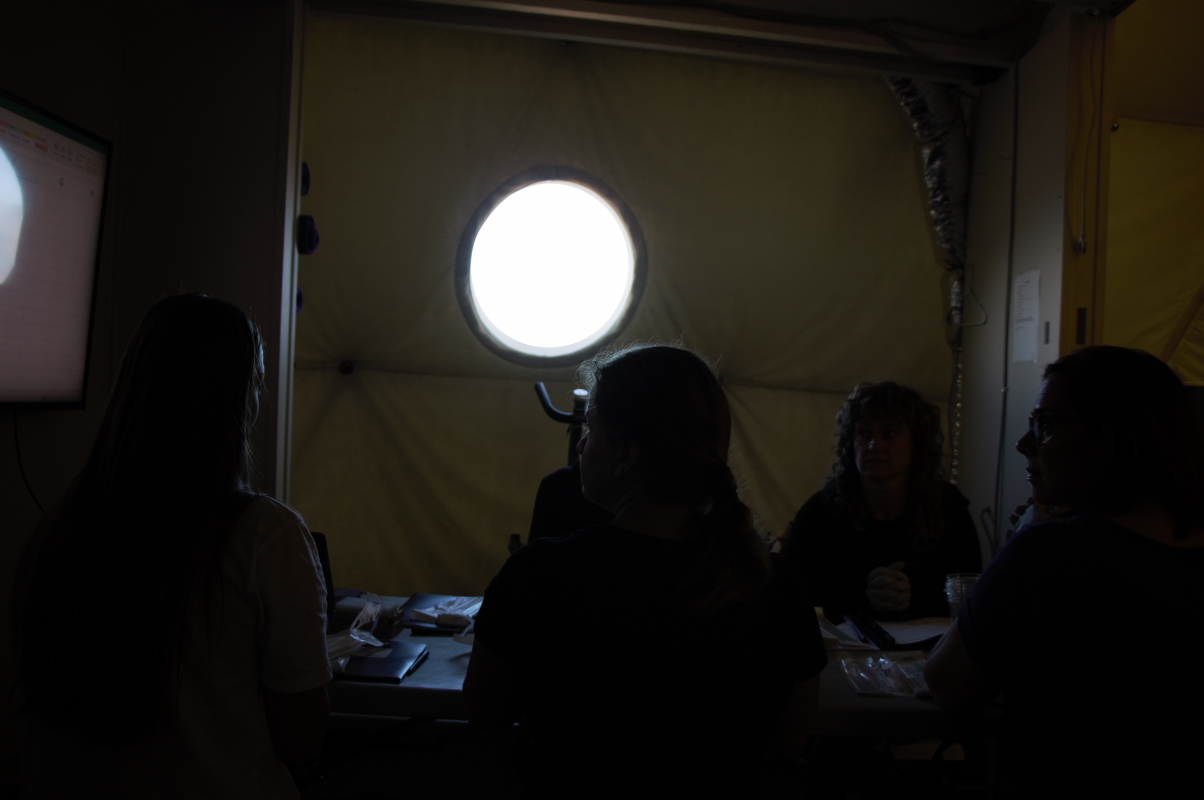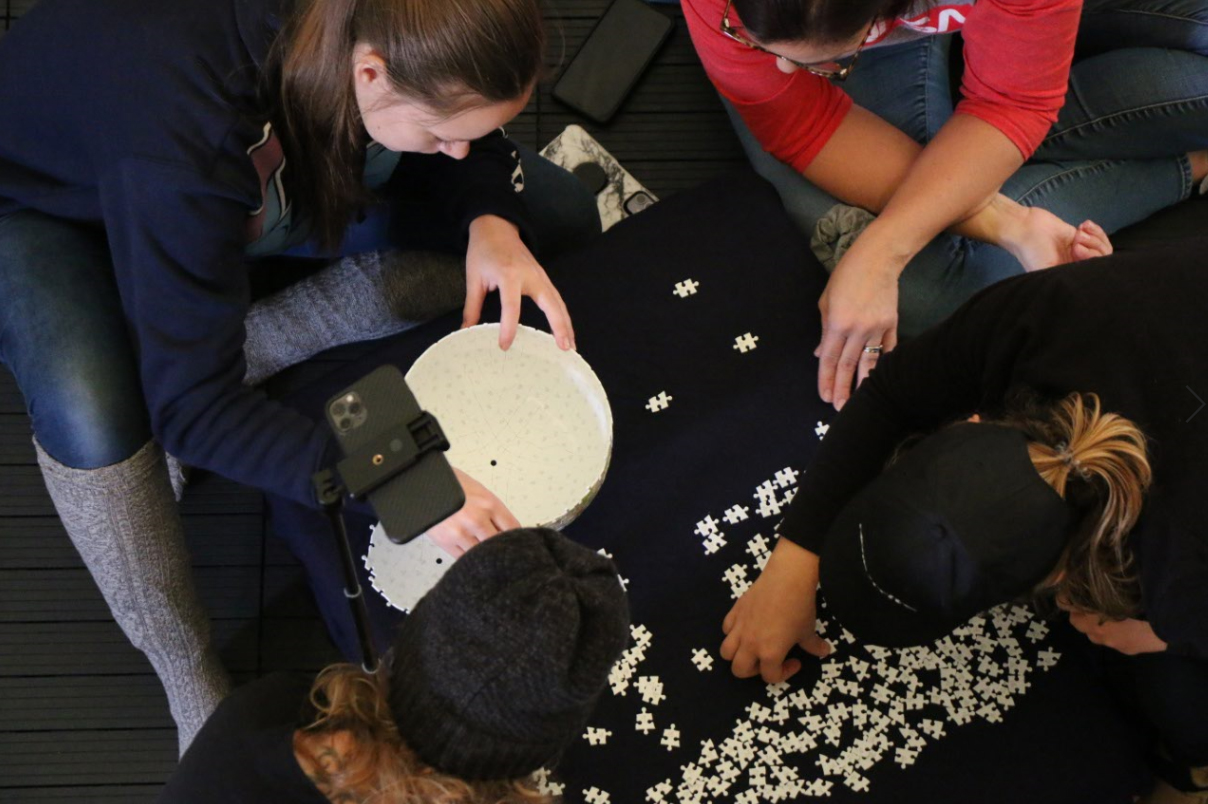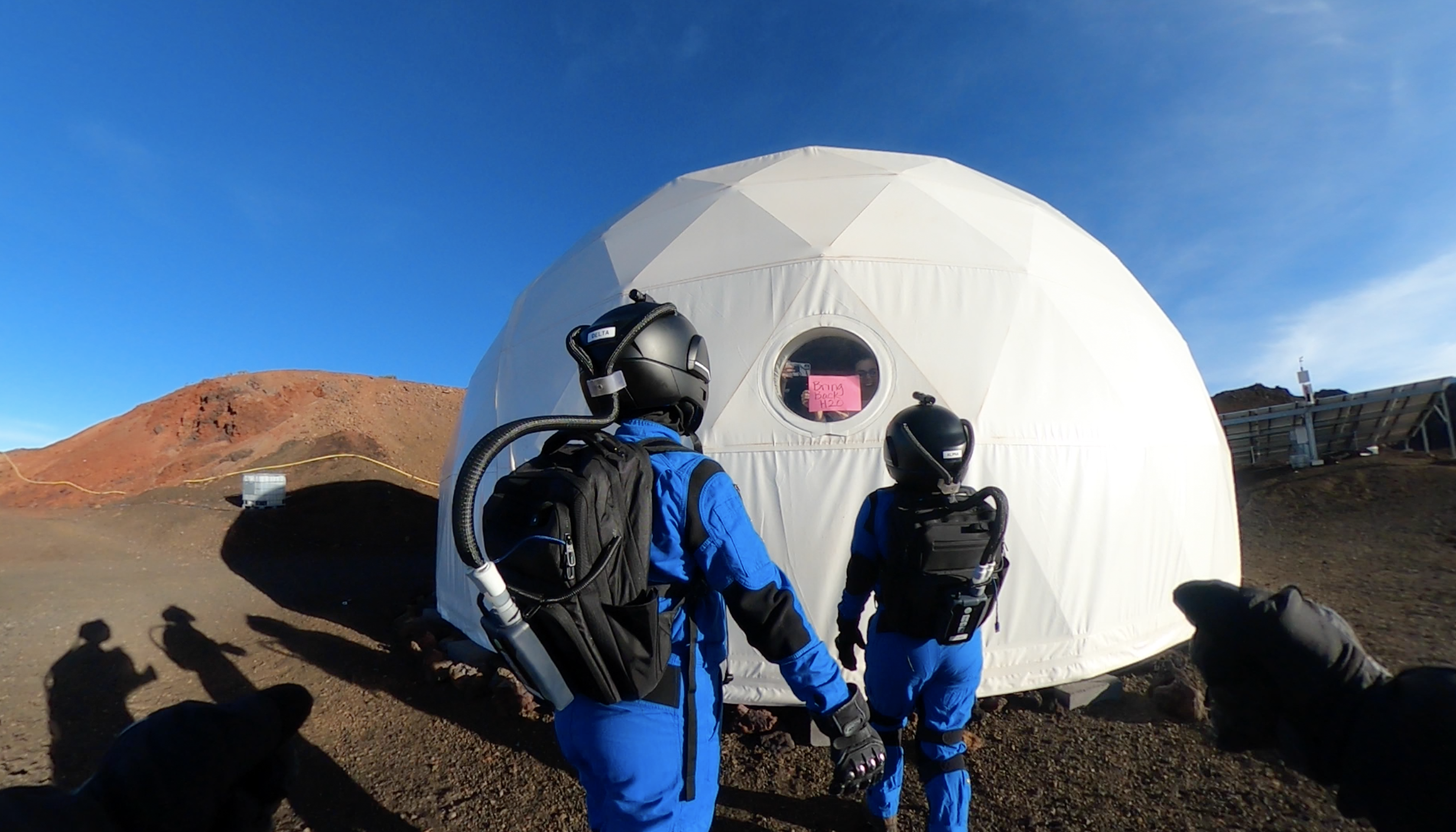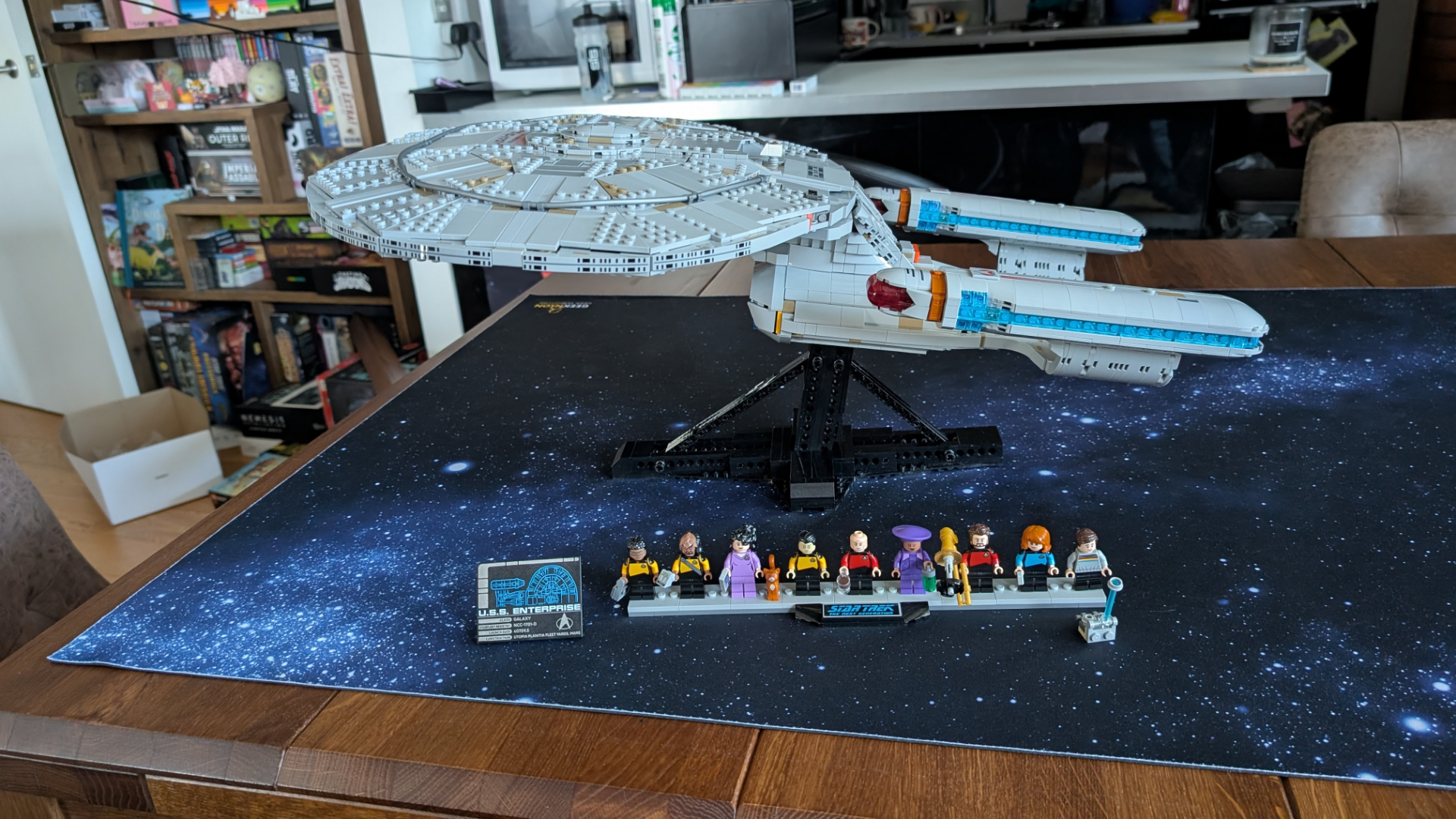A mission to 'Mars' at the HI-SEAS habitat: Live updates
Follow Space.com's Chelsea Gohd on a simulated Mars mission in Hawaii at the HI-SEAS habitat!
In November 2020, Space.com's Chelsea Gohd joined a crew of researchers for a two-week analog mission to Mars at the HI-SEAS (Hawaii Space Exploration Analog and Simulation) habitat, which is located on the side of the volcano Mauna Loa.
Gohd took part in this analog Mars mission — a mission that simulates what it would be like to live and work on Mars. Follow Chelsea's voyage to "Mars" here with complete mission updates. She "launched" Nov. 2, check out her daily entries about life on Mars right here!
Space.com is going to Mars
It's finally happening, I'm going to Mars! Well, not really, but I will joining a simulated Mars mission at the HI-SEAS habitat in Hawaii in November alongside astrobiologist and crew commander Michaela Musilova (who is also director of HI-SEAS), Air Force airman and chief engineering officer Amanda Knutson, veterinarian and chief medical officer Brandy Nunez, science writer and crew science communication officer Beth Mund and artist and crew vice commander Richelle Gribble.
The mission will be part of the Sensoria program, which aims to support underrepresented groups within the space sector.
"All of our missions will be female-led and female-majority. We, of course, will welcome with open arms our male colleagues, but we believe that women need to be placed at the center of our shared vision for space exploration, that women need to be given a platform for professional development, opportunities for research and training," bioengineer and Sensoria co-founder J.J. Hastings, who serves as the CEO of Analogs LLC, a company that backs the Sensoria program, told Space.com in January.
Next Stop: 'Mars' in Hawaii
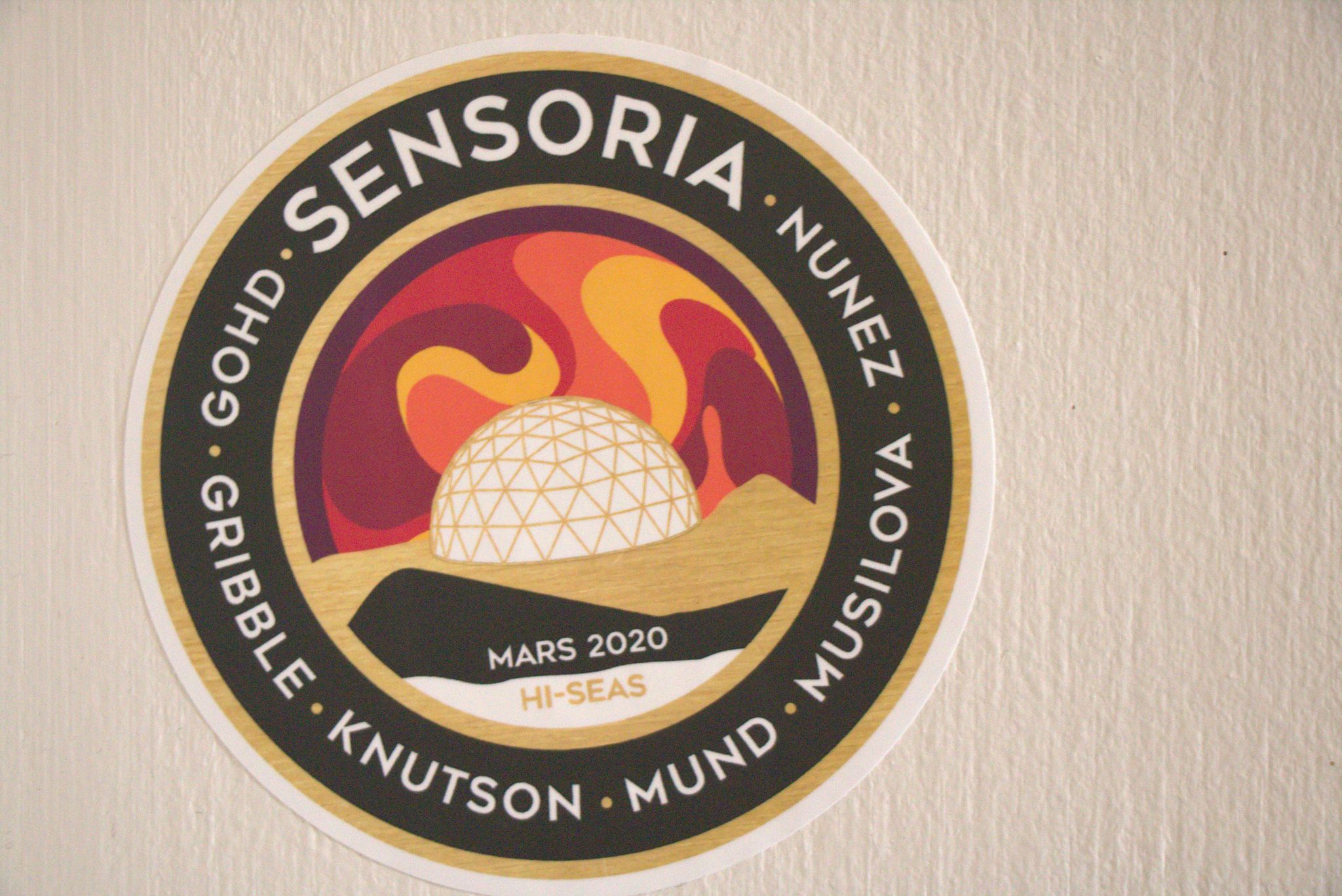
It's official, I'm on my way to Mars! This morning at approximately 8:30 a.m. PST, I touched down in San Francisco, halfway to the Big Island of Hawaii where the HI-SEAS habitat is located on the slopes of Mauna Loa.
A few of my Mars crewmembers will join me for the flight and, in just a few short hours we will arrive at Kona and quickly begin the drive to the habitat. We will be traveling directly from the airport to "Mars" to eliminate any excess risk of contamination from the novel coronavirus -- it is certainly strange leaving Earth for Mars during a pandemic, the day before a major Presidential election.
Today (Sol 2, November 3 back on Earth), I awoke to my first full day on Mars. Now, while today has been a massive learning curve in many ways, today is also the U.S. presidential election back on Earth — a strange first day on Mars for sure.
Because of the jetlag (Mars is a long way from home), I woke up a bit earlier than usual and, after stretching a bit and taking in some deep breaths as I get used to the slightly lower oxygen levels, my crewmates were awake and hard at work getting breakfast together — cooking is a task that we rotate between crew members. Over shelf stable pancakes, we discussed the day ahead, what we needed to accomplish, and how we want receive election news as it comes in. Now, our only communication with Earth is through email so those of us who wanted to be informed (which I do) emailed the mission support team, which supports CAPCOM at mission control, requesting that they email us information as it becomes available. With the communications delay we still won’t know things as they happen, but it’s relatively quick (for Mars.)
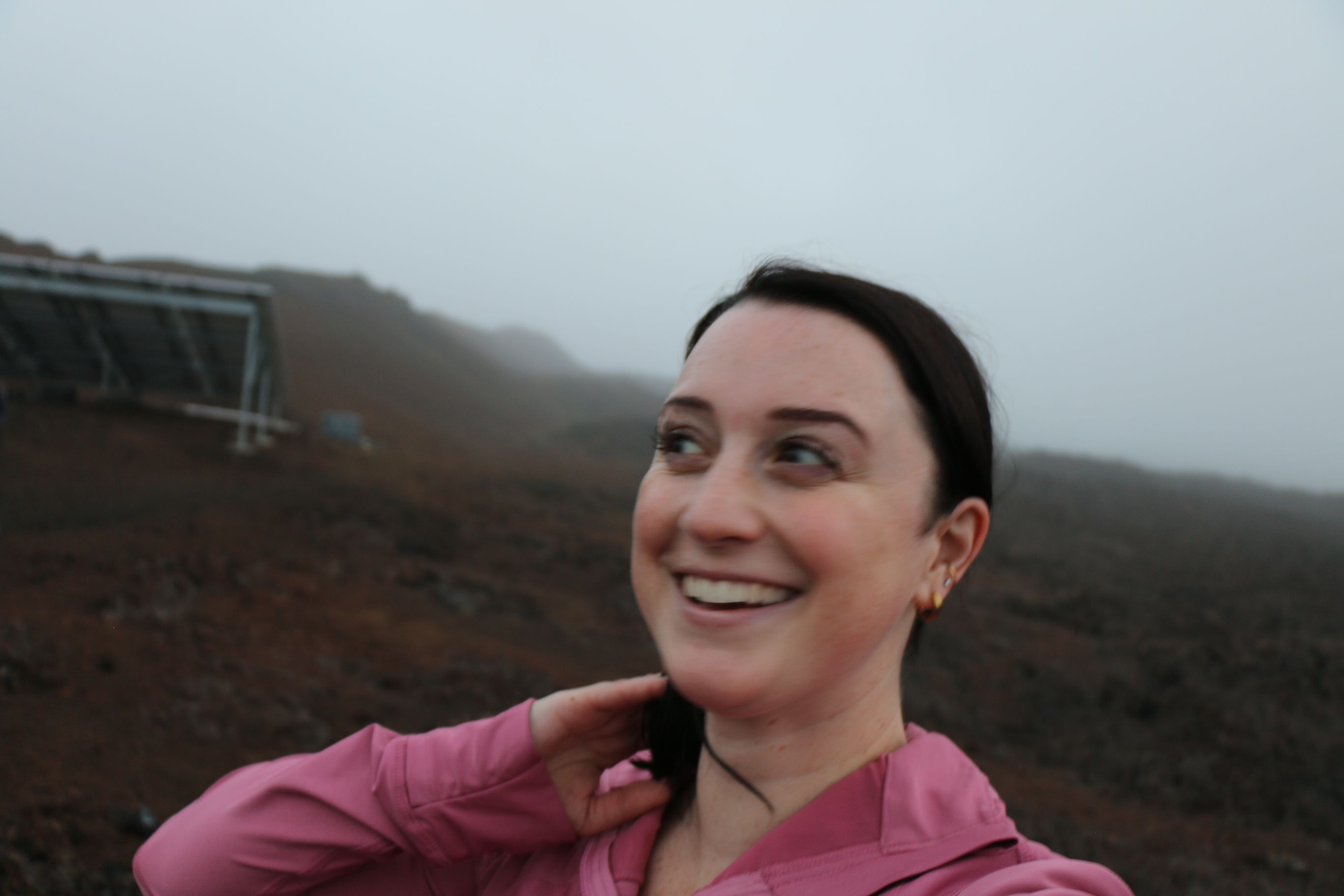
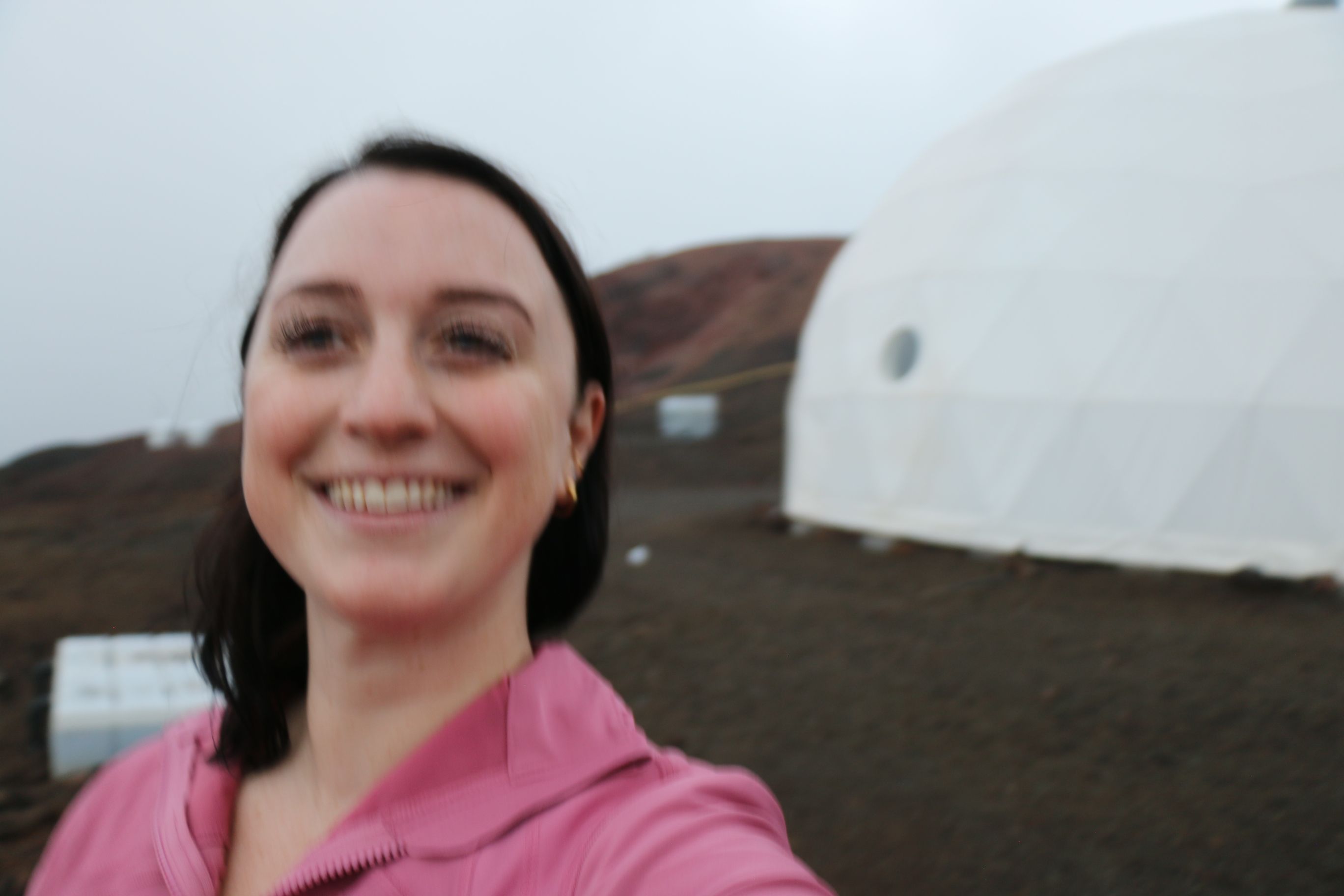
After breakfast, I conducted a microbial study — each crew member has an assigned role and, as Chief Science Officer, I conduct three of these studies throughout the duration of the mission. I led the crew through a “swab party,” where we swabbed our bodies and I swabbed the habitat. These samples will add to a body of data showing what microbes are living on us and in the habitat while on Mars.
Following the microbial study, chief medical officer Brandy Nunez went over how we will collect daily vitals (temperature, amount of sleep, general condition, food consumed) to track the crew’s health.
Next, we all went over some more details of living in the habitat — how to use the (very complicated) bathroom system, things to remember when using the kitchen and facilities, and how to conserve water, electricity and even personal energy as much as possible. We then split into teams to complete inventory of the food and cleaning supplies so we can take note of what we have to ensure we’ll have enough and to inform future crews.
Later in the evening, as clouds rolled in covering our solar array, we entered a “low power mode,” meaning that all non-essential power was eliminated — lights turned off, devices unplugged, etc. It seems as though the weather is getting slightly better so the crew is not too worried, but we will have to wait to see what comes with the weather.
I have not yet received the results of today’s election and am not sure how it will feel. It is no secret that this election is extremely charged and, being isolated on Mars with a new crew in a small space, it is certainly a unique situation. However, last night, the crew met to discuss our expectations with how we might react to all get on the same page as, with human space exploration, crew communication is key.
Sol 3: Low power on Mars
Today (Sol 3, November 4), I awoke to a cold habitat, trying in vain to switch the light on. Going downstairs to investigate further and confirmed that the habitat was (temporarily) without power. As other crewmembers awoke, we got together some breakfast that didn’t require electricity to make and warmed ourselves up.
When commander Musilova woke up, she confirmed what she suspected the night before — the overcast skies on Sol 2 (Nov. 3), caused two of the three habitat batteries to drain. And, while the third battery was close to full at 85 percent, it didn’t automatically turn on when the other two were spent. But soon after commander Musilov cycled (turned off and on again) the three batteries, they started back up, the two empty cells quickly started to charge and we had power again.
Once “on,” we resumed (and finished) the habitat inventory — checking what food and cleaning supplies we have and how much of each is left. Inventory will be completed again at the end of the mission, showing how much of the supplies we used and required, informing future missions.
Following inventory we had lunch. I am lucky in that many of the crew members on this mission are excellent chefs and bakers (personally, I’m working on it), but it is certainly an adjustment eating only shelf-stable Mars food. No fresh produce whatsoever, everything has to be rehydrated and, not only does the food taste … different … it also takes a lot longer to cook so we’ve been rotating cooking and cleaning duties.
After eating, we all resumed our individual research projects and work though, at one point we all decided that a brief nap was necessary. Here on Mars, even within our habitat, there is slightly less oxygen than we’re used to back at our respective homes on Earth. So, while we are all able to complete our research and exercise every day, it’s important that we all are careful to not push ourselves too hard physically. It’s a marathon on Mars, not a sprint.
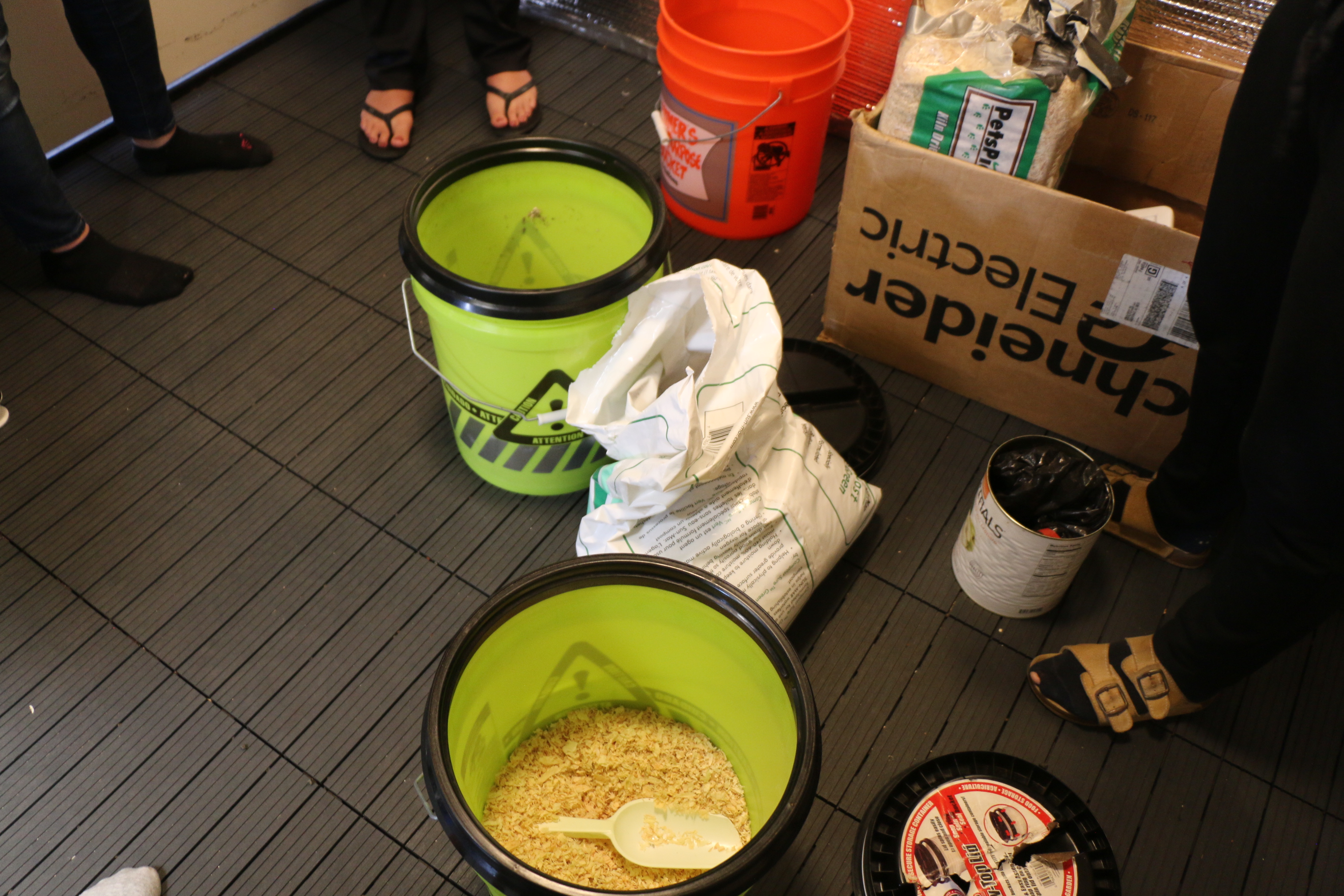
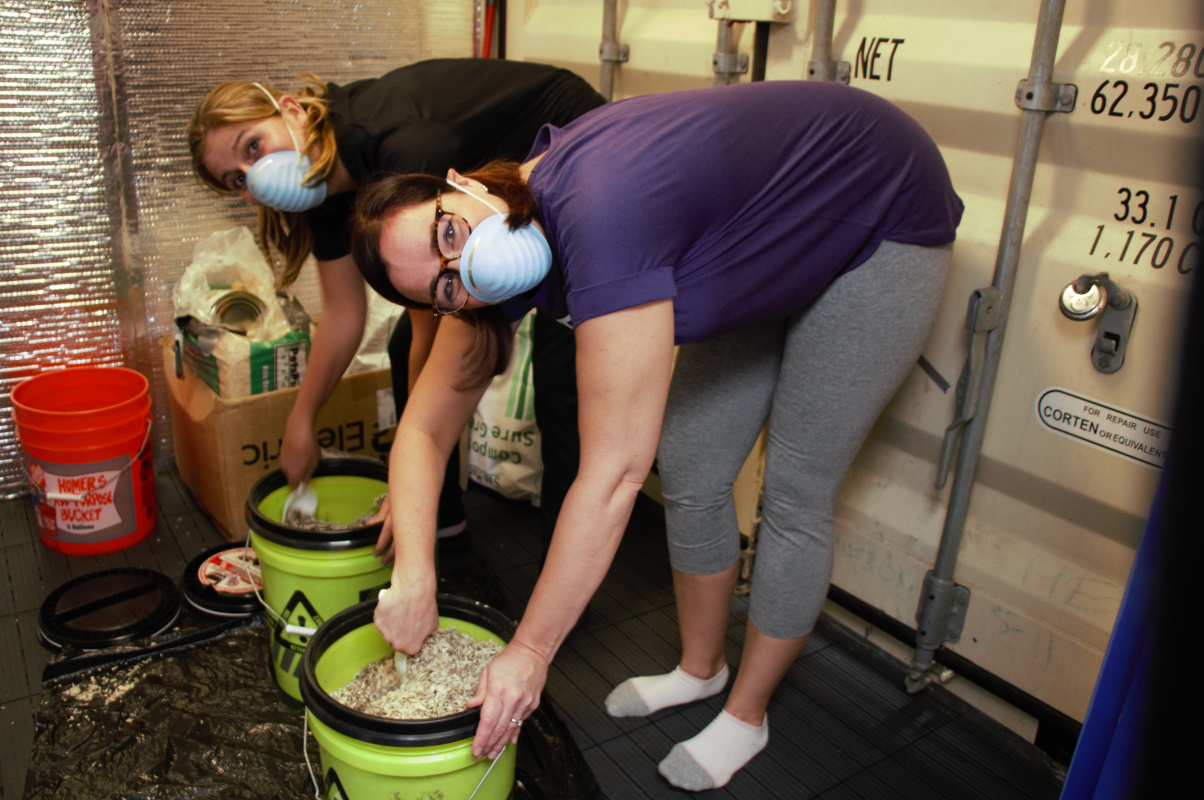

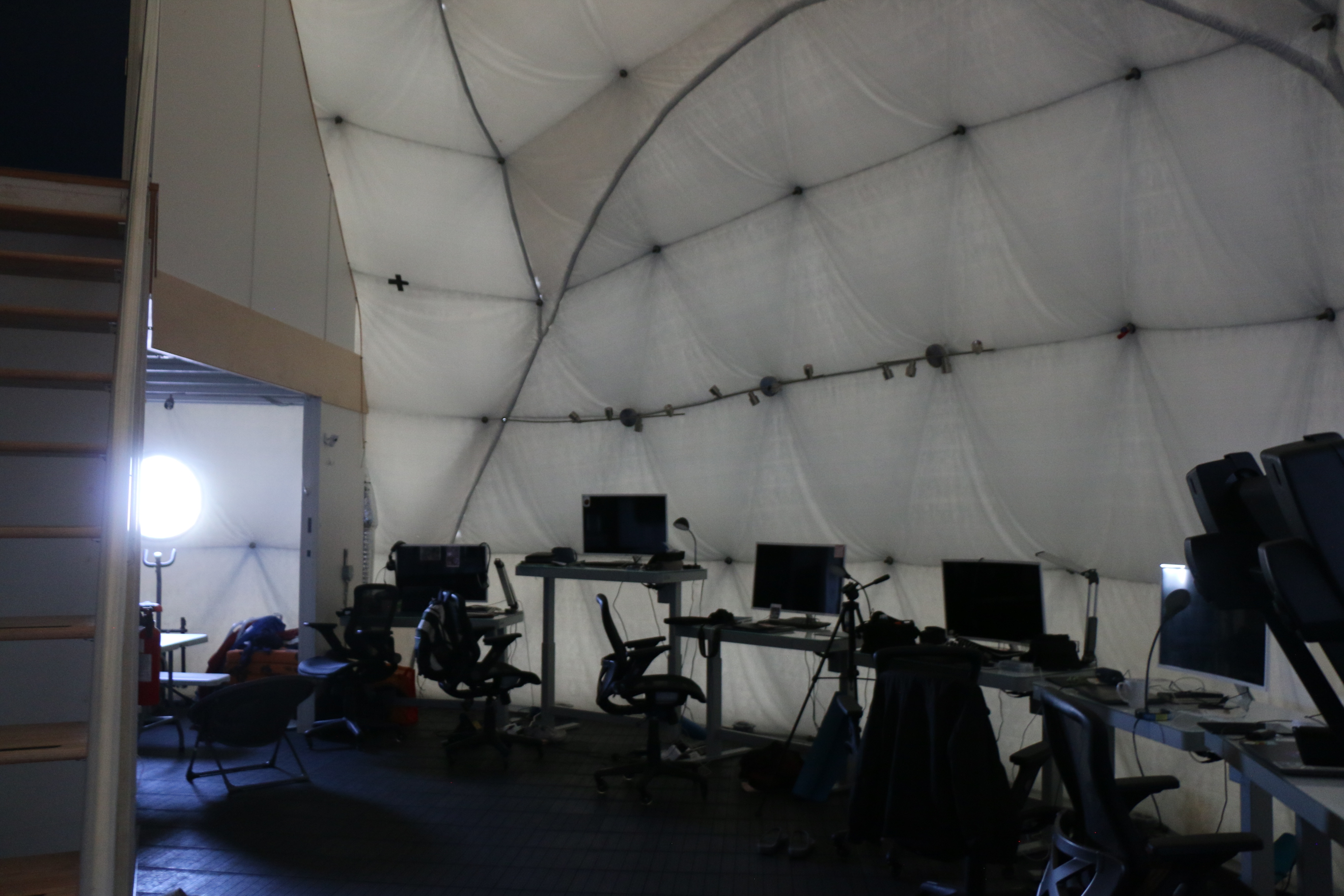
This afternoon, we had planned to complete EVA (extravehicular activity, also known as spacewalks or, in this case, Marswalks) training with Commander Musilova and potentially even go out on our first EVA, a short exploration close to the habitat. However, because we got a later start with our research and daily tasks than anticipated because of the power outage, EVA1, the first EVA of the mission, will have to wait for tomorrow (if the weather holds, fingers crossed.)
One added interesting tidbit about the mission, Sensoria M2, is that we will not have a resupply of water until Sunday.
We started the mission with approximately 64 gallons of water and, while we have plenty of water for drinking (in fact, drinking water and staying hydrated is of the utmost importance during the mission), the crew is foregoing showers until the water resupply arrives. Many of us have deodorant, biodegradable body wipes and dry shampoo to get us through the shower-less week, but it’s certainly an adjustment from the availability of water where we are all from back on Earth — certainly a luxury, we are reminded.
Sol 4: I take my first Marswalk!
Today (Sol 4, November 5), I woke up to a beautiful sunny day on Mars. I checked my email to see if there was any election news (which, there wasn’t much that was new) and I prepared for my first-ever EVA (extravehicular activity), or Marswalk!
With the habitat (or dome) now at just 9 percent water and with a resupply mission still days away (our water supply is set to arrive Sol 7 (Nov. 8)) I refrained from showering with the rest of the crew. (Don’t judge me, we need to save water to drink!)
In preparation for our first EVA (extravehicular activity, or spacewalk, which took place this afternoon, commander Musilova gave us an overview on the history of analog EVAS, and specifically EVAs at the HI-SEAS habitat. Following this presentation, she walked us through geology basics and what types of rock are local to the habitat site.
Finally — it was time for my first EVA, EVA1 for this mission. Commander Musilova walked us through how to put on our spacesuits, helmets and attach each other’s life support backpacks — and we were ready to go! After waiting in the airlock to adjust to the Martian pressures, we stepped out and I took my first steps on a Martian surface in the suit.
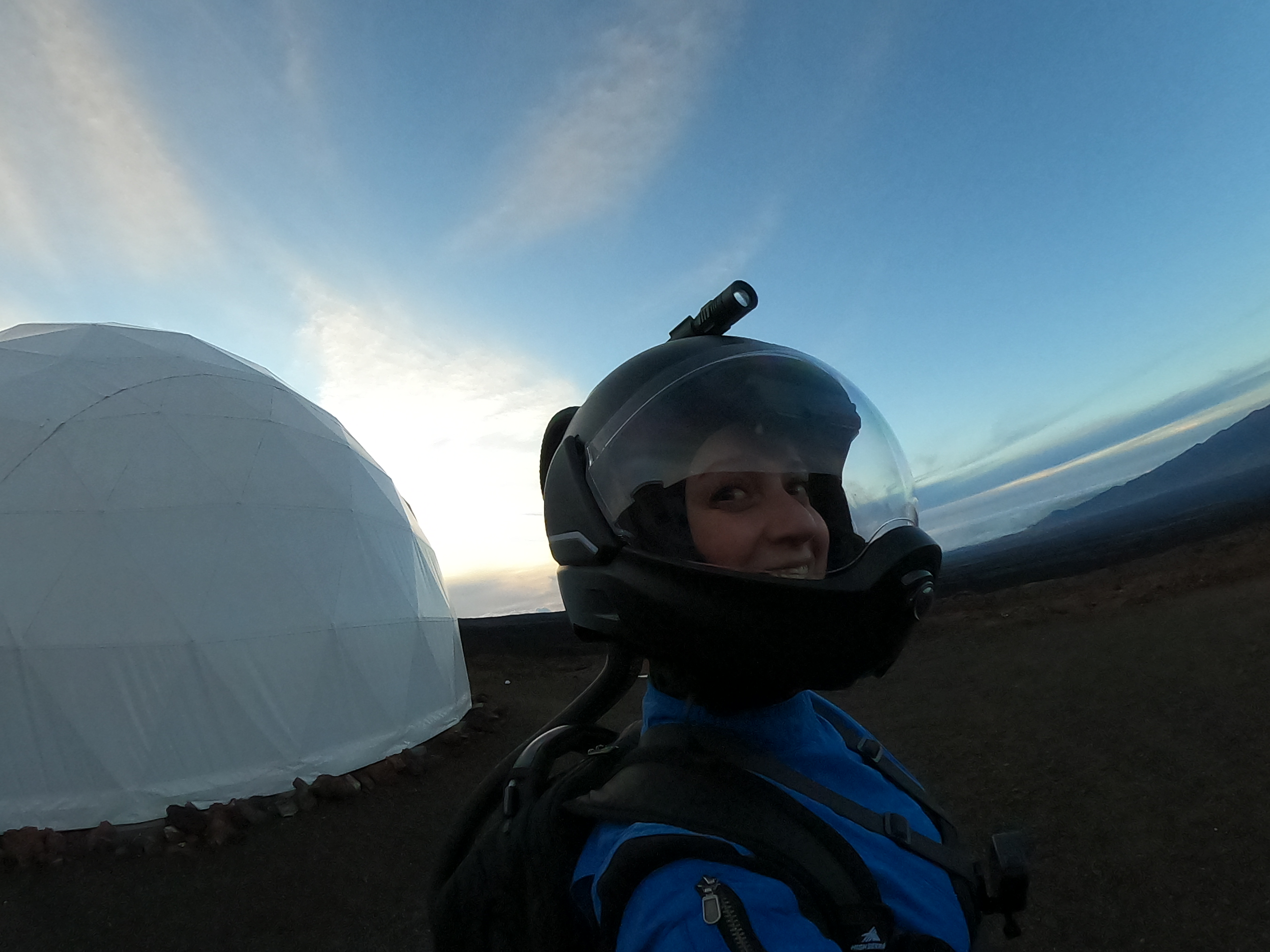

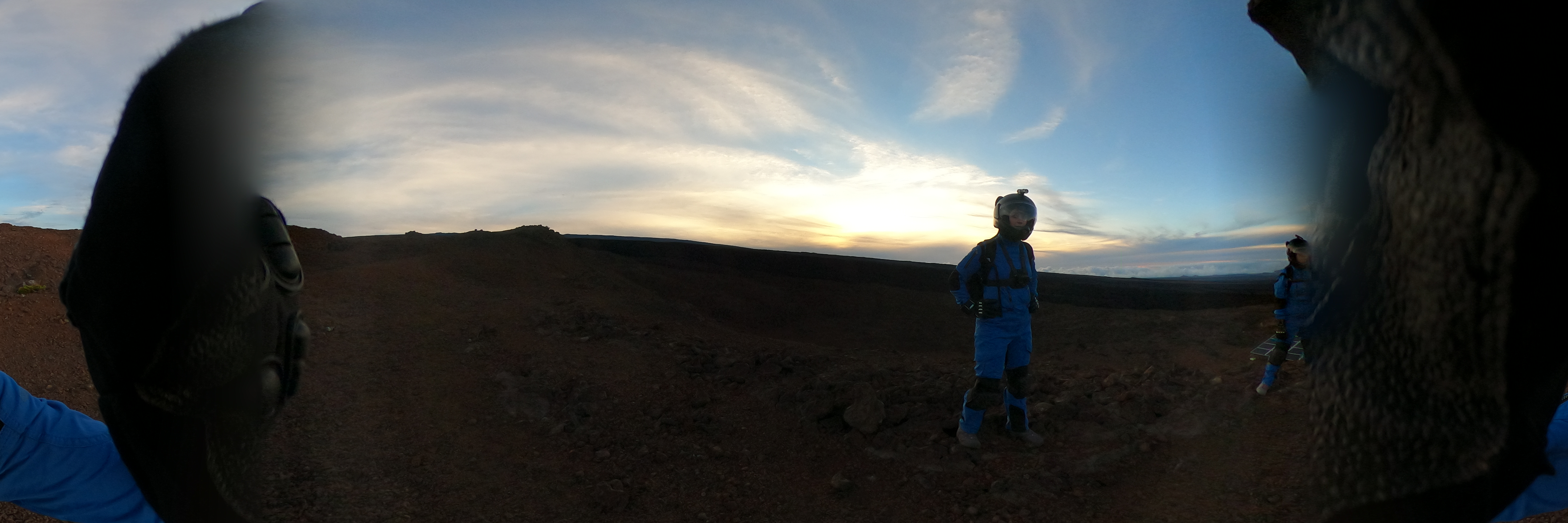
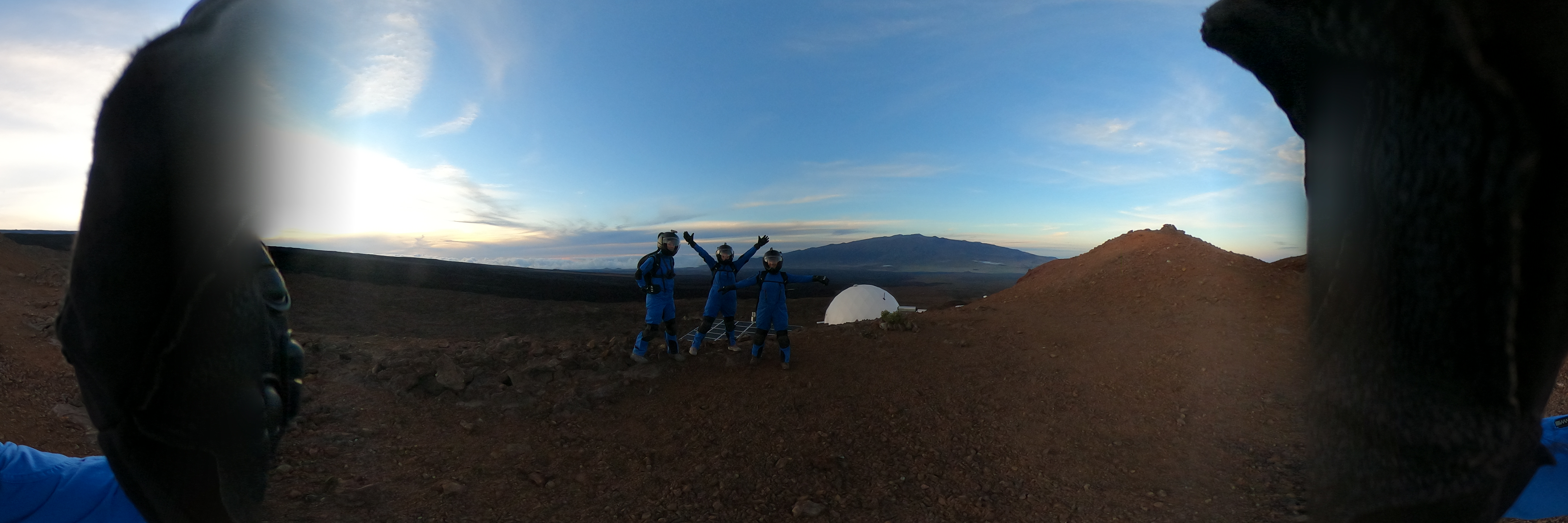

We went on a relatively short EVA — just about an hour — and journeyed out to two different locations nearby the dome. First, we went to the “waterfall of death,” as it’s been so nicely nicknamed. Funny thing, there’s no water at the waterfall of death. Rather, it’s a large crater in the volcano and, over one of the sides of the crater, hardened pahoehoe lava (smooth, flowy lava that hardens in “elephant skin” looking patterns) cascades over the edge.
After taking in the sights and catching my breath, as it is EXHAUSTING traversing the Martian terrain in a heavy helmet and life support backpack (it would be difficult without the heavy equipment, the lava rocks are tricky to navigate), we checked out “Mordor” (yes, as in THAT Mordor) — a massive lava tube that is so foreboding that not only can humans not explore it, but even robotic instruments have had serious difficulty peering inside.
Exhausted and thrilled from the adventure, we returned to the dome and stretched. I am sore and a little bit out of breath after the experience but I cannot WAIT to do it all over again.
Sol 5: Martian pancakes and EVAs
Sol 5 (Nov. 6), I woke up bright and early as usual (because of the jetlag from jumping time zones (Earth to Mars is a serious leap)) and joined my crewmates downstairs for a Martian pancake breakfast. So far, Martian pancakes are my favorite off-planet food.
Since there aren’t “weekends,” on Mars like we might have on Earth, I and the rest of the crew took this morning as a rest period, not rushing through our tasks and, instead, catching up on our Earth communications and making progress with research projects. Before I knew it, however, it was already time for the second Marswalk, or EVA, of the mission.
Because I went Marswalking yesterday (and cannot WAIT to go again), chief science communication officer Beth Mund and chief engineering officer Amanda Knutson, along with vice commander Richelle Gribble and commander Michaela Musilova ventured out onto the Martian surface today.
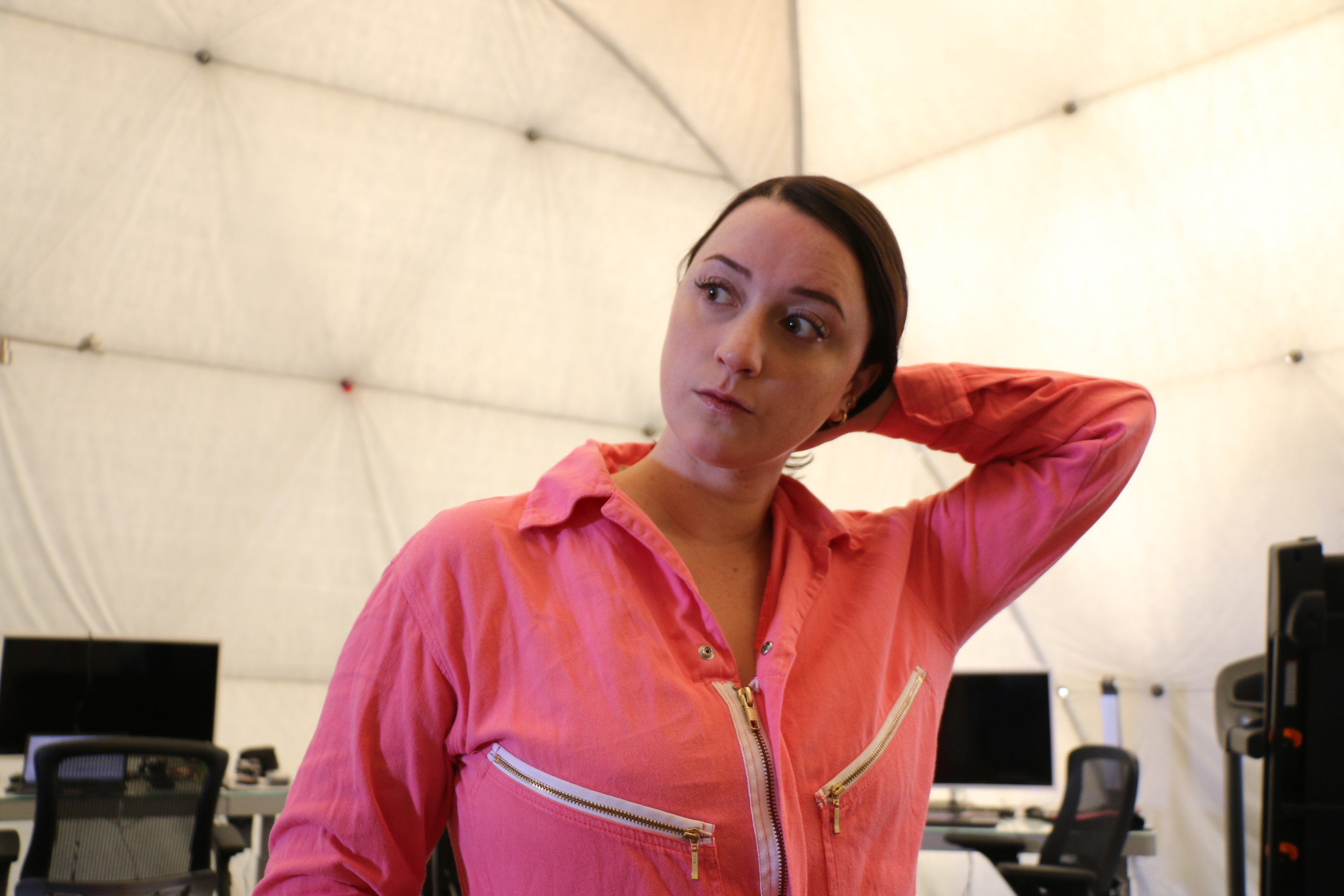
But, since I was not outside for the Marswalk, it was my duty to serve as habcom (habitat communicator), essentially keeping tabs on the crew and making sure that they were safe throughout the expedition. To do this, I monitored cameras set up around the outside of the habitat (to see them when they left and returned) and communicated with them through Bluetooth communication devices we all wore (it all felt very “Star Trek,” I’ll be honest.)
After they returned from exploring the Martian terrain and we all filed our daily mission reports (an important part of any space mission), I set the stage for a Martian rock concert.
When I’m not writing about space and science, I’m writing and playing music as “Foxanne,” so I brought a small travel-sized guitar and tonight “after hours,” I put on a performance of original music for my crewmates. The performance centered around one song, titled “Let it Ache,” (which premieres Nov. 9), which is about the winter in New York and how good it feels to feel the sun on your skin and see green things growing again. To me, the sentiment directly parallels the experiences of astronauts. For me even now, after just a few days on Mars not feeling the outside breeze or seeing lush Earth plant growth, I’m already craving its sweet, sweet return.
Sol 6: Twists and Turns
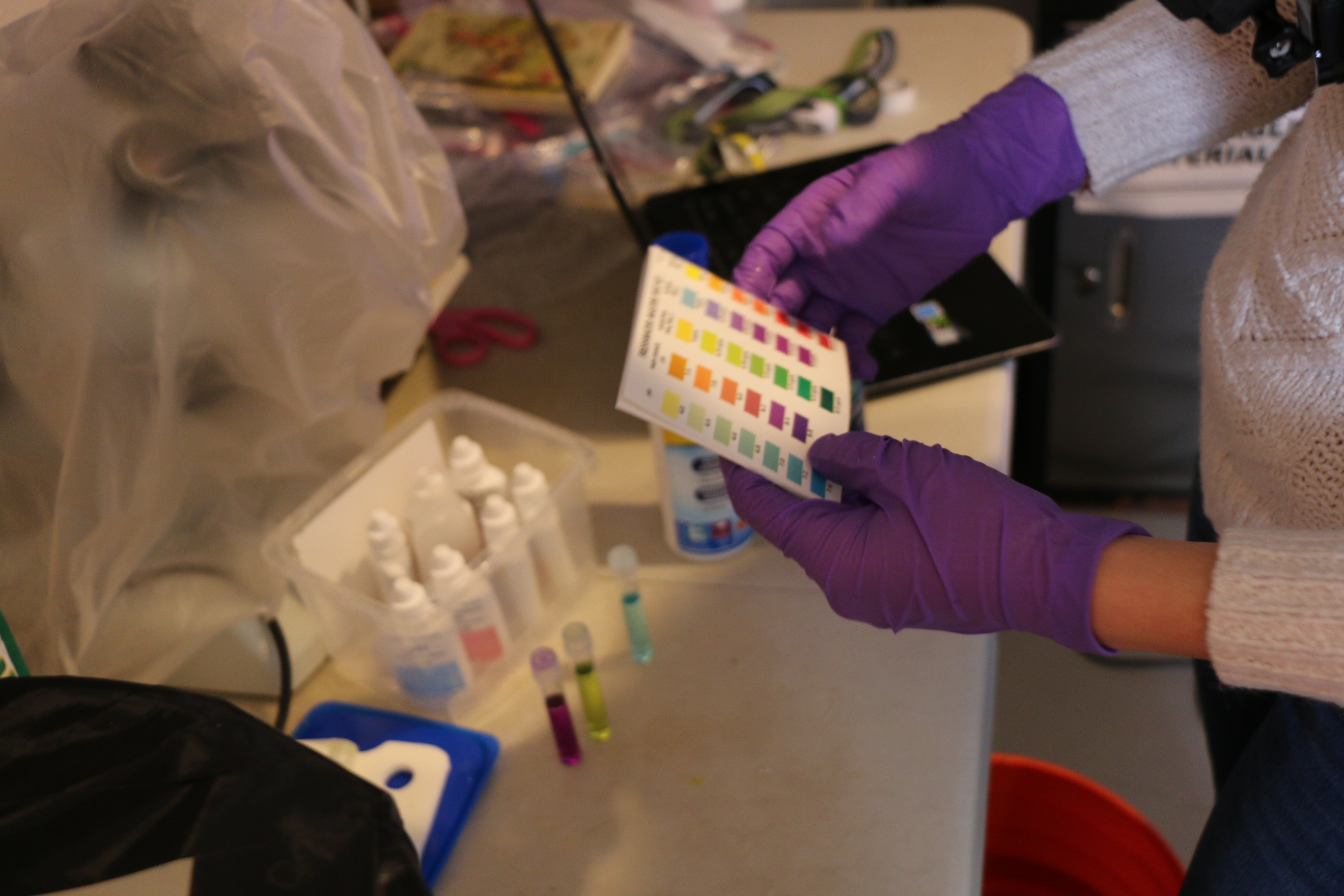
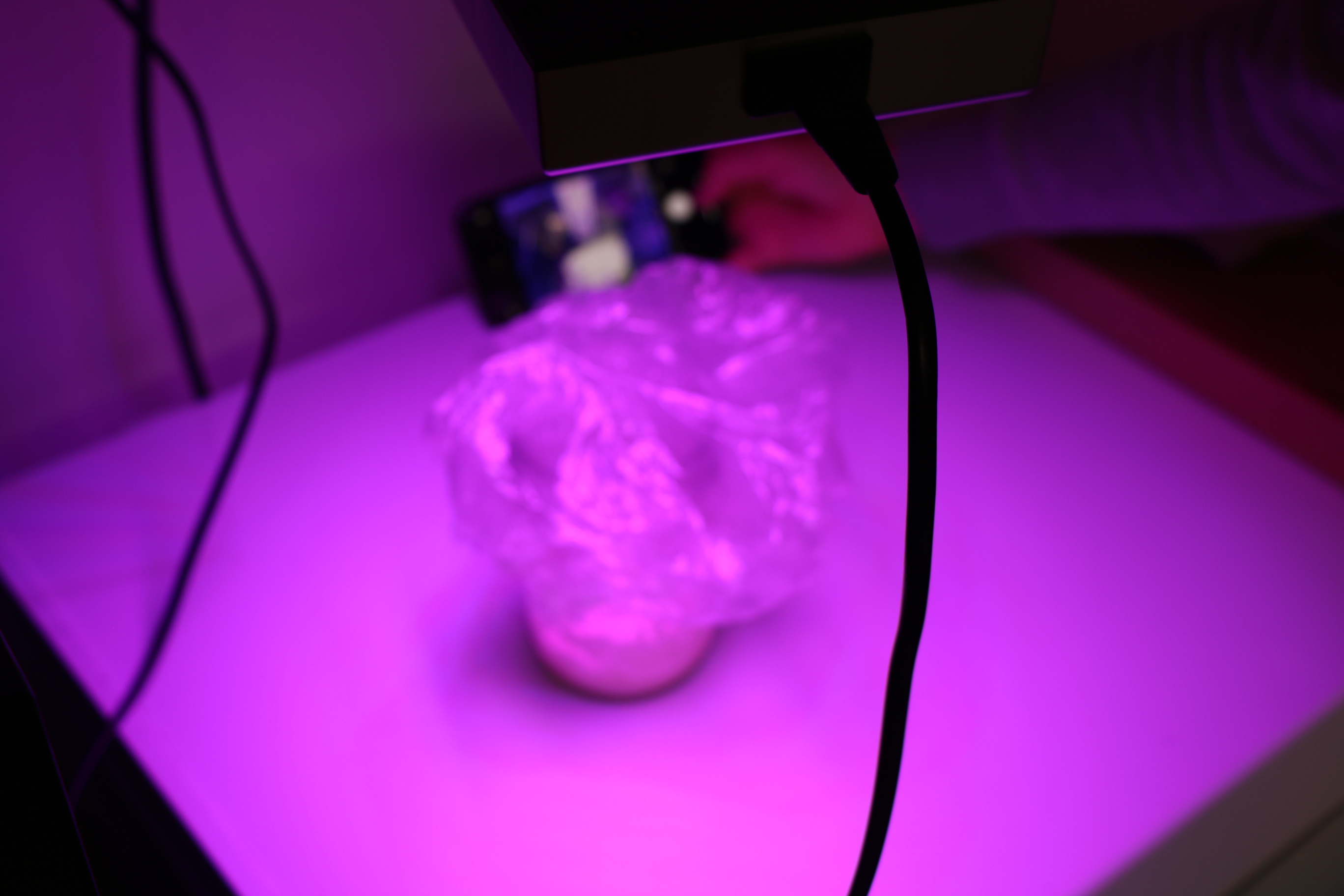

Today Sol 6 (Nov. 7) was an unbelievable day full of unexpected twists and turns. First off, as my loved ones back on Earth already knew, when I woke up and checked my email I found out that President-elect Joe Biden and Vice President-elect Kamala Harris had won the 2020 U.S. presidential election.
The news followed days of not knowing, checking my emails sporadically hoping for little bits of information about the election. But, between the time zone difference and the 40-minute communication delay (our only communication with Earth is through email and it takes 20 minutes each way to send a message), bits of information were few and far between.
While the mission control support team helped to keep me informed, following the election was certainly different than it would have been on Earth — watching the news, following articles and statistics live and communicating in real-time with friends and family.
Following the election news and some more Mars food (I am lucky to have crewmates with exceptional cooking skills, but I cannot wait to taste real, fresh Earth food again) I prepared for what was supposed to be the third Marswalk of the mission.
However, a storm raged through the morning and didn’t die down in time to conduct the Marswalk today. Even with mildly inclimate weather, it is not safe to go out on a Marswalk, as it can make it more likely to slip on the lava rocks outside, and poor weather can threaten the life support systems that we wear.
So, instead of risking health and safety outside, my crewmates and I stayed inside and continued our EVA (extravehicular activity), or Marswalk, training, going over the different lava tubes nearby (my favorites right now are Mordor and the Sarlacc Pits) and getting used to using our communication and navigation devices that allow us to stay connected to the habitat via Bluetooth and find out way around the rough terrain using GPS coordinates.
We then worked on our projects and research inside the habitat. Hopefully tomorrow, I will travel out back to Mordor and venture to see my first Martian lava tubes.
Tomorrow will be an exciting day for other reasons as (finally) our drone resupply will land and we will have enough water to shower. After about a full week without showers, we are all very excited about the incoming water.
Sol 7: Drone resupply on 'Mars' and a Shower!
Today (Sol 7, November 8, 2020) was a fantastic day. The first spectacular Martian moment of the day was finding when I woke up that, in the early hours of the morning, a “drone resupply” had delivered more water for our little habitat.
This was really good news because, prior to the delivery, the entire habitat (including drinking water, our sinks and shower) were down to 6% water, or just 29 gallons. To be fair, we only started with 64 gallons and were surprisingly effective at conserving water over the first full week in the habitat. But while we will continue to conserve water (a serious concern for astronauts living off-Earth with limited supplies) this delivery meant that we would (finally) be able to take showers on Mars! (Hallelujah).
This was especially good news because this afternoon I, along with three of my Martian colleagues, put my spacesuit back on and ventured back out into the Mars terrain. We explored out to a lava tube and back — an exhausting but incredible journey that took us about 3 hours.
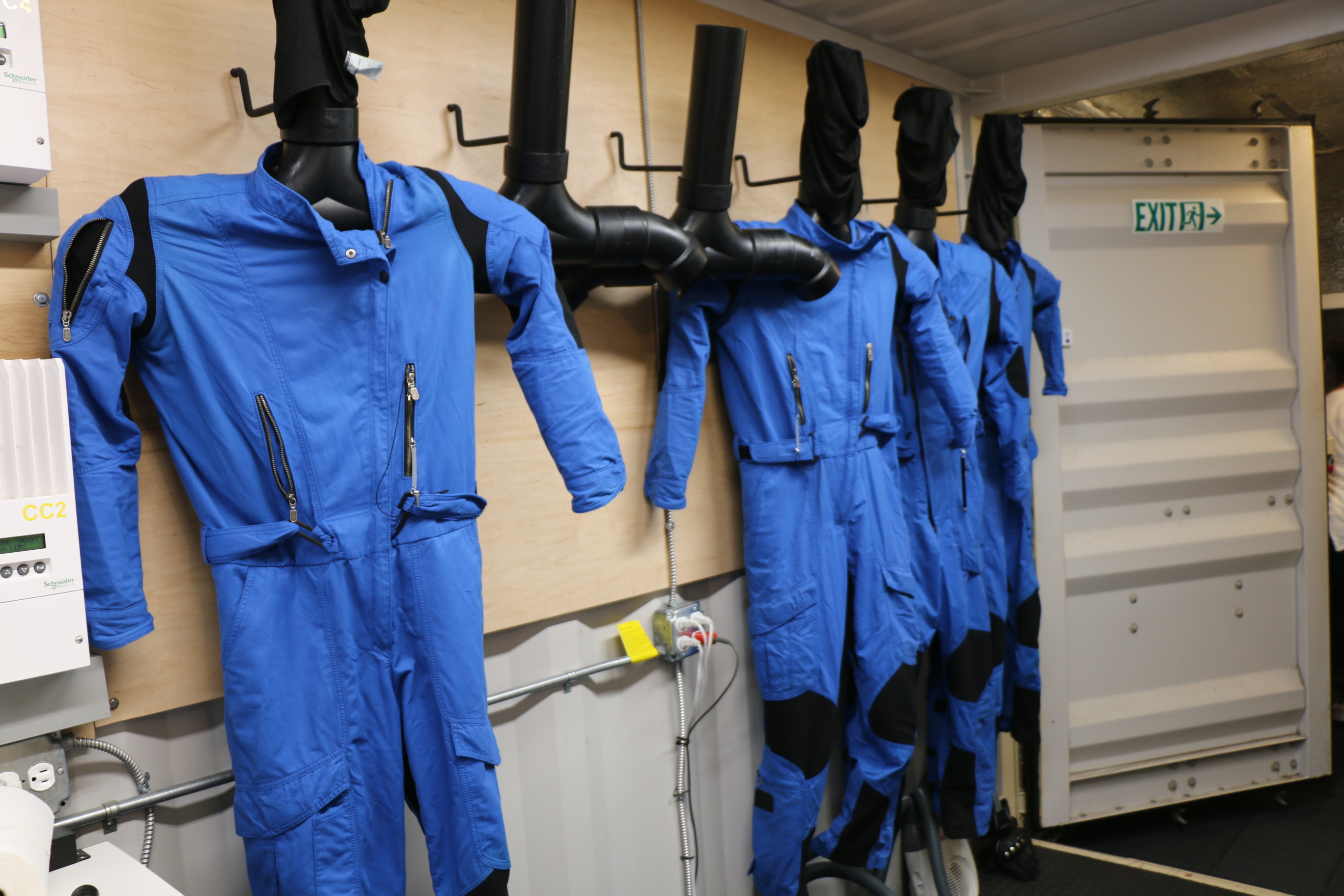
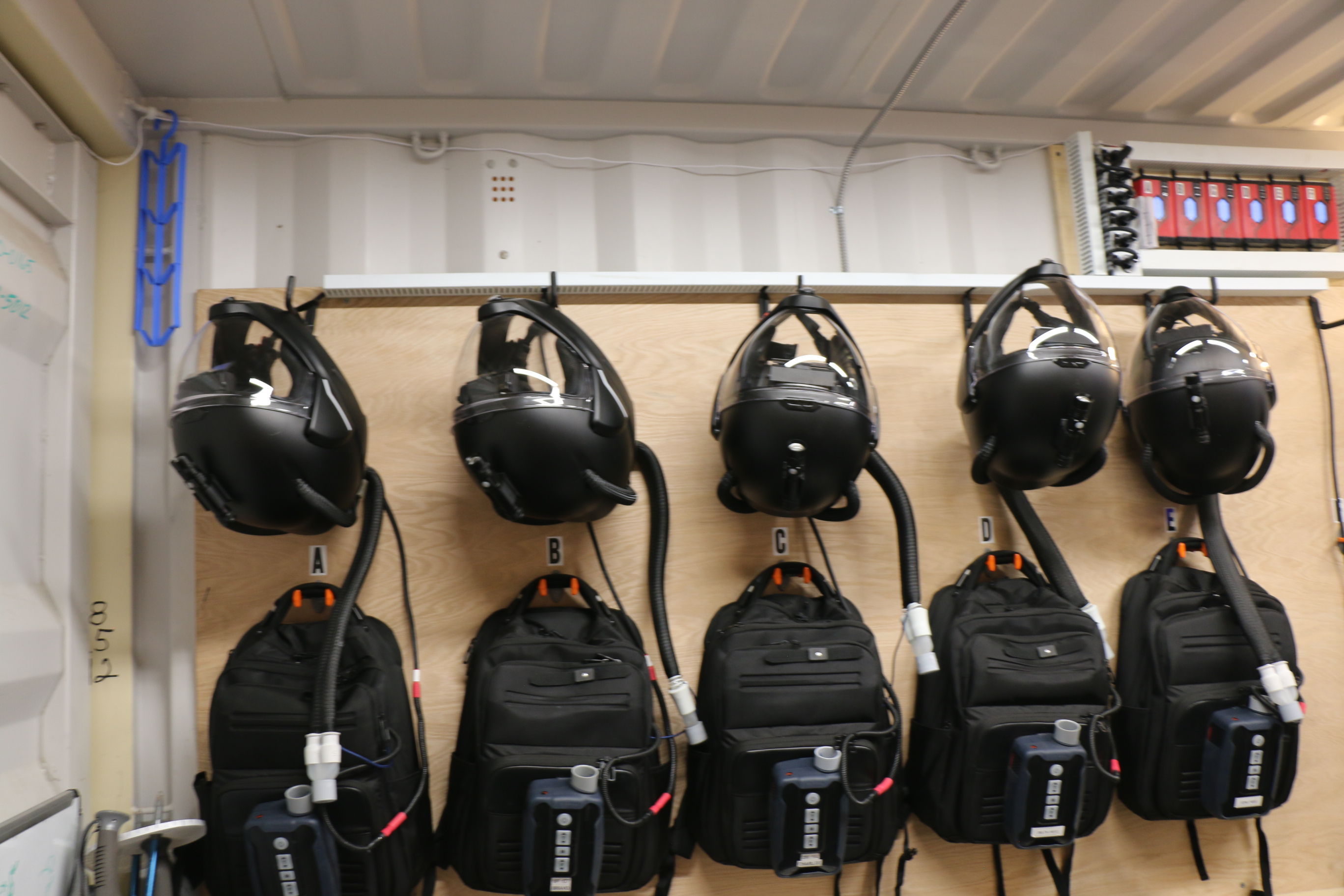
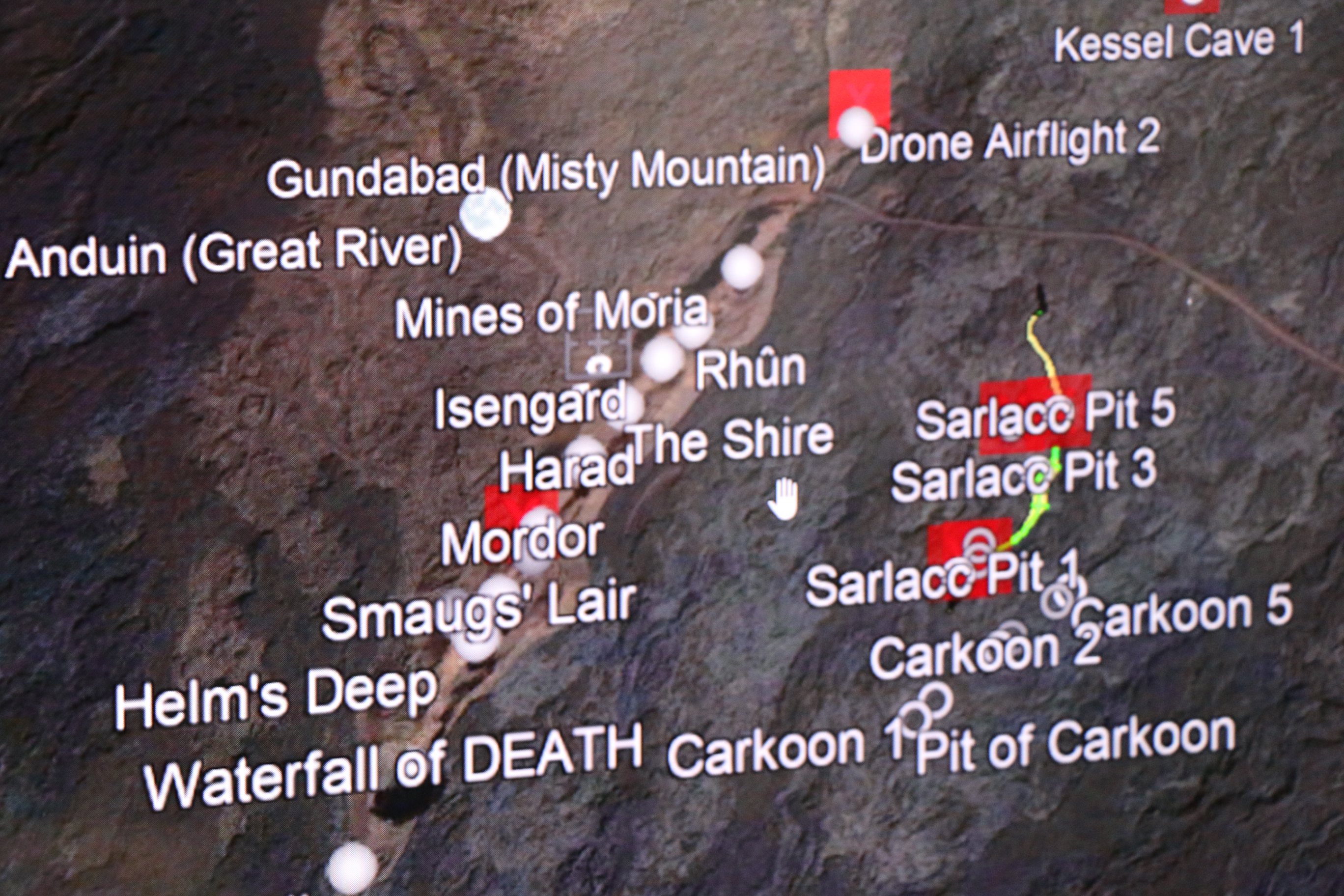
Getting to the skylight (the opening in the Earth leading to a lava tube) which led us into the lava tube underground was no small feat. With a heavy helmet and attached life support backpack, we climbed over smooth pahoehoe and crumbly, difficult ‘a’a to get to the site. Once there, we carefully climbed down into the lava tube, careful not to put our full weight on rocks before testing if they might give way.
We continued to climb through the lava tube, now with flashlights illuminating the way. As we trekked, patches of brilliant white started to appear on the cave walls and ceiling. As commander Musilova explained, this is the type of material that NASA Goddard is studying to see if it is created by life or not. By studying extreme microscopic species in extreme locations such as this, scientists can study what life on other planets like Mars might be like and get a better idea of where they may exist.
In addition to being a scientifically fascinating site, the cave was also astoundingly beautiful, with brilliant white stalactites and a stunning assortment of rock types. It truly felt like I was on an alien world, both in the cave and throughout the entire expedition.
Sol 8: Expect the Unexpected
Today (Sol 8, November 9, 2020 back on Earth) was an interesting day on Mars and a quick lesson that one: space is hard, and two: expect the unexpected.
When I went to brush my teeth after waking up this morning nothing came out of the faucet. Strange, I thought, as yesterday (Sol 7, Nov. 8) we just got a fresh “remote drone” water resupply and should have a full water tank. But, as I quickly learned, while we had a full water tank, an issue with our water system was stopping the water from actually getting to us (oh, the irony).
The crew and I went to work filling up pots and bowls of water from the one sink that any water was coming through (and it was a mere trickle as best) just in case it was quite a while before we had a fully functioning water system again.
To get a closer look at what was wrong with the water system, commander Musilova and officer Knutson teamed up for an emergency EVA (extravehicular activity, or “Marswalk”). While they suited up in spacesuits to go outside the habitat to investigate, I served as HABCOM (habitat communicator) from inside our little dome home.
As HACOM, I used a Bluetooth communication device to communicate with the crew on the Marswalk. I also monitored the cameras surrounding the habitat to keep an eye on them — overall, ensuring that their mission was a safe one.
Still with no clear answer as to what was wrong with our water system, commander Musilova contacted the “remote drones” that refilled our water the day before and they returned to help us assess the situation. It turned out that our water pump had broken and so they rolled off again into the Martian sunset to retrieve a spare pump and water tank from storage nearby. Following our recent power outage, it was almost comical that we were already having another major issue. Making light of the situation, the crew blasted the Beastie Boys’ “Sabatoge,” while writing our mission reports about the day.
Tonight following dinner, I will also be fulfilling my role as Chief Science Officer and will conduct the second of three microbial studies to be completed throughout the mission. Nicknamed “swab parties,” during these studies I lead the crew through swabbing things like the insides of their cheeks and the airlock door. The results of this study will show what microscopic creatures were living on us and our environment while on Mars.
Sol 9: Water woes and hula lessons
This morning (Sol 9, November 10 back on Earth), I woke a bit more sluggishly than usual — the water catastrophe of Sol 8 seems to have tired me and my crewmates out. But there is no time to waste on Mars so, as we ate breakfast made with some of the emergency water dropped off by the “repair bots” who worked on our water system on Sol 8 (Nov. 9), and got to work planning our day.
Because we were still without water and a dust storm had rolled in, a Marswalk (or EVA (extravehicular activity)) was off the table for the day. However, while we were all sad that we couldn’t don our spacesuits and head out into the treacherous Martian lava rocks, it gave us the space to use the afternoon and evening to work on our individual projects.
But, while we all spent time on our own research and work, we all took some time together to complete a 3D puzzle of planet Earth as a crew — a teamwork exercise that reminded us of the planet we’ll be returning to in just a few short days, or sols.
After the puzzle-building and a brief hula lesson with our commander of many talents, the repair bots had returned to fix our water system and it was time to spring into action. We regained a brief trickle of water from the sink in the laboratory, so we emptied the now near-empty emergency water jug into nearby pots and pans and, using a big bowl and a funnel, captured as much water as possible.
Luckily, the bots were successful and (finally) we had a working water pump again! However, while our faucets were running again, we were glad to have collected the extra water because, as we have quickly learned — anything can (and will) happen on Mars.

Hopefully tomorrow doesn’t bring another crisis, severe technical malfunction, dust storm, or other catastrophic anomaly. However, if it does, it seems like we as a crew are equipped to handle pretty much anything Mars throws our way.
Sol 10: A breath of "fresh" air
Today (Sol 10, November 11) was a breath of fresh (well … as fresh as it gets inside a dome I can’t leave).
The past week and half, our crew has endured a new crisis near every day: from losing power to losing water for multiple days to a near-constant barrage of “Martian dust storms.” But, while the weather wasn’t good enough to go out on a Marswalk today (the life support backpack cannot fare the storms, and climbing over lava rocks in a heavy spacesuit during a storm isn’t a great idea safety-wise), it was fantastic going through today without having to worry about having water or power.
Leaving Earth will quickly remind you to not take for granted what many of us are lucky to have back at home.

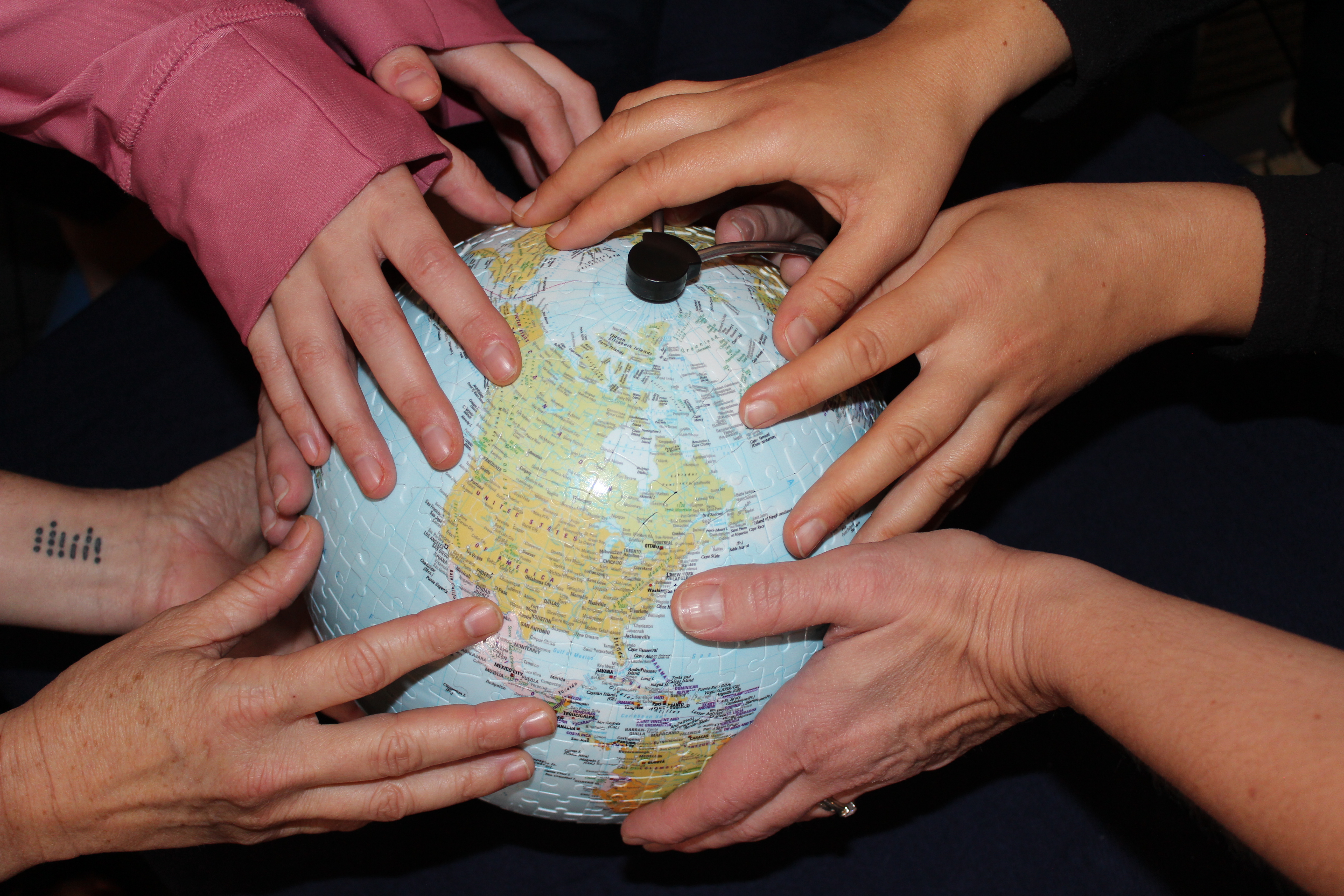

While stuck inside for another day, crew members worked on their individual research projects. But I will admit, while it was nice to be able to work inside the dome without an immediate crisis underway, 10 days into the mission and having only stepped outside for two Marswalks thus far, I am itching to get back outside again. Even feeling the breeze against the outside of a spacesuit can feel refreshing if you haven’t breathed fresh air in over a week.
Perhaps the biggest mistake we as a crew have made so far is mentioning pizza. I can’t remember exactly how it slipped its way into conversation but wow, what I wouldn’t give for a breath of fresh air and a slice of pizza today.
We’ve been making do with our freeze-dried peas and dehydrated tomato powder but Mars food is certainly … different.
Sol 11: Cold days on 'Mars'
Today (Sol 11, November 12, 2020) was another stormy day on Mars. It has been very cold and windy on Mars (as expected) but these last few days the weather has gotten a bit more extreme, with thick dark dust clouds rolling in, obscuring our view out the window and making it too dangerous to go outside on Marswalks.
But as the afternoon neared — a beacon of hope on the horizon! The grey, hazy, cloudy sky gave way to a brilliant bright and clear sky. This meant that not only was a Marswalk possible today, but we could see through our habitat window — our mere porthole to the world — again.
A few of my crewmates suited up for the fourth Marswalk of the misson. However, as they got ready, the clouds rolled back in. The bad weather quickly returned but, while they didn’t make it to the lava tubes today, they thankfully were able to go out quickly to turn on our hot water and take out the trash to a nearby receptacle.
When on Mars, if the trash (and other waste) isn’t taken out somewhere, it will remain inside the habitat. So while they are disappointed to miss out on the lava tubes today, we are all greatly thankful (greatly, greatly thankful) that they took one for the team and took out the trash.
Tomorrow I’m hoping to venture out onto the Martian terrain for another Marswalk but it’s strange: as I near the end of my mission I feel both like I’ve been here for AGES and, at the same time, that I’ve just arrived. Everything really does work different on Mars it seems … even time.
Sol 12: Painting on Mars
Today (Sol 12, November 13) was weird and magnificent on Mars.
To start, I whipped up a batch of Martian pancakes for the crew while hoping that the dust storms still raging outside our little dome window would subside. I crossed my fingers that, perhaps, the weather would clear enough at some point in the day that we would at least be able to go outside for a brief Marswalk (foreshadowing … I got my wish).
In the early hours of the day, I dipped my toe into Martian art-making. Officer Gribble, a professional artist, brought “spira,” or blue spirulina algae powder and iron oxide powder, the reddish-brown pigment that’s behind the Red Planet’s signature color, to the habitat. Because actual paints might be too heavy (and therefore expensive and difficult) to take to Mars, by using local materials like iron oxide or by growing colorful algae, future Martian travelers could paint, write and make art using such sustainable, available ingredients.
Upon dipping my brush into the iron oxide and spira with just a few drops of water, I was amazed how much they resembled more traditional watercolor paints. The activity was an interesting lesson in Martian art materials and a seriously stress-relieving experience. After nearly two weeks on Mars, I needed a fun, creative escape like this. Seriously.
In the afternoon, I peeked out the window and saw that for a brief moment the weather had cleared up — Hallelujah!
Me and three of my crewmates raced to suit up to get outside before the foul weather returned. Honestly, after stuck inside a little dome for nearly two weeks with only brief moments outside while suited up, it was an enormous relief even feeling the breeze on the outside of my spacesuit.
Just like I’m living in an analog Mars experience, I’m also experiencing “analog wind” outside as, with the wind on the outside of my spacesuit and some air flowing in my helmet from my life support backpack, it *almost* feels like the real thing.
Me and my crewmates ventured back out to Mordor (and, again, no one threw a ring in. Littering on Mars? No chance) and took in the breathtaking scenery and the excitement of both the exploration and the challenging, physical experience that Marswalks bring.
However, just 30 minutes into our mission, I noticed some signs of returning storms on the horizon and saw my crewmates walking towards me. We hurried back to the habitat and just in the nick of time as, when we arrived back at our little dome home, another storm erupted and we had to duck back into the airlock for safety.
Now, while it was disappointing that we had to end our adventure early, I am grateful for every morsel of time that I had outside. While this is an analog mission, standing out on the side of a volcano in a spacesuit looking out over a landscape of red lava rocks and nothing much more, it’s feeling more like Mars every day.
Sol 13: A Birthday on Mars
Today (Sol 13, November 14) has continued our mission’s theme of “expect the unexpected.”
First, we woke to wish crewmember Beth Mund, a science communicator who has worked as a speechwriter at NASA and who runs the Casual Space Podcast, a happy birthday. She, in turn, shocked us all with a blue wig. This followed in a long line of blue-themed crew jokes, as crewmember and artist Richelle Gribble brought heaps of “spira,” blue spirulina algae powder, to Mars with her and we’ve been putting it in and on just about everything.
Following a celebratory morning, we looked outside to see that, again, dust storms would make Marswalks impossible for the day. While disappointing, we held out hope that perhaps the sky would clear for an evening Marswalk or even a brief peek outside in a spacesuit. Alas, this wish did not come true.
Instead, leading up to dinnertime, we noticed that all of the clouds and stormy weather had obscured our solar panel so much that we had to go into low power mode. In fact, as I write this, the clock is ticking down until we are in “no power mode.”
As I near the end of this two-week analog mission to Mars, I think I have learned not just to expect the unexpected (power losses, water losses, ongoing (and sudden) storms and a host of other surprises) but to more deeply appreciate my home planet. While I am not orbiting Earth looking down at our home planet, I think that being a part of an analog mission like this does still create somewhat of an “overview effect,” a psychological effect observed in astronauts where their perspectives on life change as they look back at Earth from space.
Our home planet is a beautiful, precious and delicate thing. And, as the lights dim, my power wanes and dehydrated potatoes remain the only food we can cook without power (Mark Watney was onto something) Earth is looking better and better.
Sol 14: Last day on 'Mars'!
Today (Sol 14, November 15), has been my last full day on Mars and holy smokes was it a trip.
To start, I woke to a powerless habitat. While we expected this after starting to lose power last night (while watching “Star Wars: The Force Awakens” to celebrate crewmember Beth Mund’s birthday), it was still an adjustment for all of us waking up to a freezing cold habitat in the morning. The dust storms from the night before had briefly let up but dust clouds in the distance promised more storms throughout the day.
The morning and early afternoon were primarily comprised of us all trying to keep warm while communicating with mission control and working to regain power. Without sunshine to power our solar panels and an emergency generator that was slow to start, it took a while before we had power back. Thankfully, we eventually got there.
Throughout the day, we painted as a crew, completed the end-of-mission inventory, started packing for our return to Earth and — the highlight of our day — watched a replay of SpaceX’s Crew-1 launch which was a soaring, spectacular success. After battling curveballs thrown by Mars all mission, seeing the four astronauts lift off on a smooth and safe launch was exactly what the crew needed today.
Speaking of inspiring moments throughout the mission — we as a crew received a surprising special message from an astronaut who has inspired all of us throughout our careers. NASA astronaut Christina Koch sent our crew an inspiring message. Living on Mars has not been easy and this message brought me and the rest of the crew a surge of hope and determination that really did get us through to the very end.
To cap off the mission, we all spit into tiny tubes — an activity that will lead to our DNA being transported to the moon with the company LifeShip. A planned 2021 launch aboard a ULA (United Launch Alliance) rocket will carry a collection of human DNA samples, including samples from our crew. The DNA will be delivered to the lunar surface aboard the Peregrine lander by the company Astrobiotic, which is set to land near the moon’s North Pole.
Even though I am only a single night’s sleep away from returning to Earth, it still seems so far away. Perhaps we’ll get another loud, dome-rocking dust storm tonight; maybe the power or water will cut out again — who knows. Space exploration, even analog space exploration, is unpredictable. Whatever happens, these two weeks (though it feels like months) have proven that I and my crew can seriously roll with the Martian punches.
